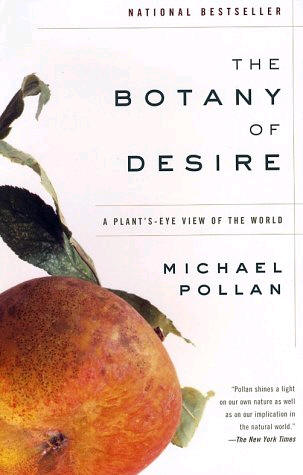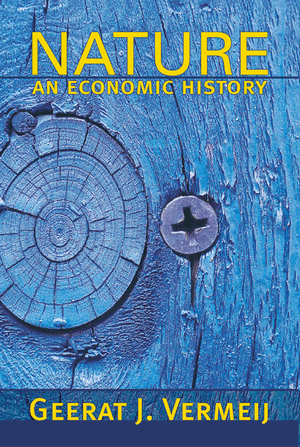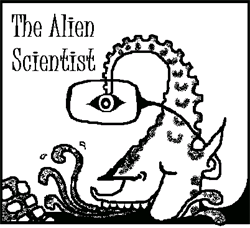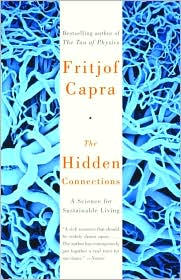
| LarryFrolich.com |
 |

From The Botany of Desire: [bold type mine]
This book’s broader subject is the complex reciprocal relationship between the human and natural world, which I approach from a somewhat unconventional angle. I take seriously the plant’s point of view. …
Plants are so unlike people that it’s very difficult for us to appreciate their complexity and sophistication. Yet plants have been evolving much, much longer than we have, have been inventing new strategies for survival and perfecting their designs for so long that to say that one of us is the more “advanced” really depends on how you define that term, on what “advances” you value. Naturally we value abilities such as consciousness, toolmaking, and language, if only because these have been the destinations of our own evolutionary journey thus far. Plants have traveled all that distance and then some—they’ve just traveled in a different direction.
Plants are nature’s alchemists, expert at transforming water, soil, and light into an array of precious substances, many of them beyond the ability of human beings to conceive, much less manufacture. …A great many of the chemicals plants produce are designed by natural selection, to compel other creatures to leave them alone: deadly poisons, foul flavors, toxins to confound the minds of predators. But many other of the substances plants make have exactly the opposite effect, drawing other creatures to them by stirring and gratifying their desires….
The one big thing plants can’t do is move, or, to be more precise, locomote. Plants can’t escape the creatures that prey on them; they also can’t change location or extend their range without help.
And so, about a hundred million years ago plants stumbled on a way—actually a few thousand different ways—of getting animals to carry them, and their genes, here and there. This was the evolutionary watershed associated with the advent of the angiosperms, an extraordinary new class of plants that made showy flowers and formed large seeds that other species were induced to disseminate. Plants began evolving burrs that attach to animal fur like Velcro, flowers that seduce honeybees in order to powder their thighs with pollen, and acorns that squirrels obligingly taxi from one forest to another, bury, and then, just often enough, forget to eat.
About ten thousand years ago, the world witnessed a second flowering of plant diversity that we would come to call, somewhat self-centeredly, “the invention of agriculture.” A group of angiosperms refined their basic put-the-animals-to-work stratey to take advantage of one particular animal that had evolved not only to move freely around the earth, but to think and trade complicated thoughts. These plants hit on a remarkably clever strategy: getting us to move and think for them. Now came edible grasses (such as wheat and corn) that incited humans to cut down vast forest to make more room for them; flowers whose beauty would transfix whole cultures; plants so compelling and useful and tasty they would inspire human beings to seed, transport, extol, and even write books about them. This is one of those books.
So am I suggesting that the plants made me do it? Only in the sense that the flower “makes” the bee pay it a visit. Evolution doesn’t depend on will or intention to work; it is, almost by definition, an unconscious, unwilled process. All it requires are beings compelled, as all plants and animals are, to make more of themselves by whatever means trial and error present. Sometimes an adaptive trait is so clever it appears purposeful: the ant that “cultivates” its own gardens of edible fungus, for instance, or the pitcher plant that “convinces” a fly it’s a piece of rotting meat. But such traits are clever only in retrospect. Design in nature is but a concatenation of accidents, culled by natural selection until the result is so beautiful or effective as to seem a miracle of purpose.
By the same token, we’re prone to overestimate our own agency in nature. Many of the activities humans like to think they undertake for their own good purposes—inventing agriculture, outlawing certain plants, writing books in praise of others—are mere contingencies as far as nature is concerned. Our desires are simply more grist for evolution’s mill, no different from a change in the weather: peril for some species, an opportunity for others. Our grammar might teach us to divide the world into active subjects and passive objects, but in a coevolutionary relationship every subject is also an object, every object a subject. That’s why it makes just as much sense to think of agriculture as something the grasses did to people as a way to conquer the trees.
--Michael Pollan, The Botany of Desire, pp. xvi-xxi

Review from Alien Times [link]: "In his book Nature: An Economic History, Geerat Vermeij applies economic concepts - such as competition for resources, functional specialisation and economies of scale - to the natural world. The book has been described as 'Economics, as if written by intelligent aliens', perhaps because the human world is treated impartially alongside the rest of the ecosystem. (In fact, due to the authoritative treatment of marine snails, the book might be especially appreciated by intelligent alien molluscan Earthologists)."

From Nature: an Economic History: [bold-face type mine]
Yes, we are very powerful, and we can do things no other living things on Earth can do; but, I shall argue, our enormous power and reach have not allowed us to conduct economic life with rules fundamentally different form those that apply to living things generally. The differences are real, but they are differences in amount and scale, not in kind. In effect, economic ideas apply to an enormous diversity of systems, of which ours lies at one extreme of a continuum. In so many words, this chapter is an invitation to human-centered readers to learn about the rest of life, and to naturalists to think about human society and history in biological terms. --Geerat Vermeij, 2004. Nature: An Economic History, p. 39.
Although we usually think of the word economy in such human terms as trade, profits, markets, and finance, it applies just as aptly to the systems of which living things other than humans are constituents and architects…An economy is a collective whole, a system of metabolizing, interacting, smaller units or entities that are themselves economies. The constituent units adapt to, and bring about changes in, their environment as they compete locally for energy and material resources. Economies are built on living things, which complete cycles of work by coupling chemical transformations that alternately use and release energy in the context of an architecturally and organizationally constrained physical structure. Economies thus have knowable properties not possessed by any one of their individual members. The work of life—growth, replication, and activity—creates meaning and information and ultimately leads to a history in which self-interested parties who cooperate to fashion larger wholes give rise to and replace each other. Evolution—descent with modification—is thus an expected and universal historical process in economic systems. It occurs because economic units compete locally for resources, and because only those entities that acquire and retain the necessities of life in the face of such competition and of uncertainty persist. Cooperation among economic players reduces rivalry at one level, but creates more potent competitors on a larger scale. Trade and cooperation (or mutual exploitation) thus lead through self-organization, or co-construction, to regulation of resource supply and consumption, and to complex interdependencies that emerge as the common good for the larger economy and for many of its constituents, especially for those that wield disproportionate power.
--Geerat Vermeij, 2004. Nature: An Economic History, pp. 1-2
How should performance be measured? Economic entities succeed or fail through competition for energy (the product of force and distance, expressed in joules) and its material equivalents. It is energy that entities exchange during interactions. Energy is therefore a currency, or means of exchange, for valuing economic activity. In the monetized economy, money substitutes for energy. Money acts as a means of valuing resources; we buy and sell goods and services with it, but money does no economic work by itself. Economic activity, however, is not just about energy; it is also about time. Being first in the market with a product can be more important than being the best; the risks of injury or death can be minimized by quick action. The appropriate measure of performance is therefore power, expressed in watts, and defined as energy (or work) per unit of time.
Power as a measure of performance and money or energy as a measure of exchange are obviously linked. Price—the amount of money paid or received for goods and services—is determined by the rate of production or supply (productivity), the rate of consumption (demand), and the extent to which producers and consumers control information about these rates. Producers, for example, may know more about (or have greater influence over) the market than do consumers, and may often be in the position of creating demand by advertising. Price is thus determined by power, even if we pay it only in units of money or energy. Price integrates availability, use, risk, and information as these relate to buyer and seller.
It is well known that rates are extremely sensitive to the amount of time over which they are measured. Just as phenomena vary in space, they vary through time. The longer the interval over which a rate is measured, the more this small-scale temporal variation is integrated and smoothed out. In other words, information is lost as the interval over which rates are calculated lengthens. Fluctuations in price depend in part on how often critical information about supply and demand is assessed. Power and price measured over the long run will not be the same as power and price calculated in the short term. The calculations used should match the time scale or lifespans of the entities whose performance is being measured. This issue of compatibility of time scale has rarely been raised in the economic works I have consulted.
Measuring economic performance in units of power will strike many economists and biologists as peculiar and unfamiliar. The reasons for this unease arise from common word usage. The word power as employed in everyday speech refers to influence, control, the implied or actual use of force, or the imposition of the will of one party on others. Whether this power is used or only implied, it is based on power in the strict physical sense, as energy per unit time. I shall therefore use the word power throughout this book in both the strict physical meaning and, to my mind equivalently, in the more metaphorical sense familiar to politicians, historians, and sociologists. Furthermore, each discipline has its own jargon for power as a measure of performance. To economists performance is usually expressed as profit. In the currency of money,l profit can be employed to enrich the producer, to reinvest in the producing firm, to fund new ventures either by the firm itself or by its investors, or to be redistributed as tax by the state for the real or perceived public purpose. To ecologists, performance is measured as net productivity, the power beyond that needed for subsistence. The excess thus becomes available for growth, reproduction, or consumption. Evolutionary biologists are accustomed to fitness as a measure of performance. Fitness in this technical sense means the surplus of power devoted to offspring. This reproductive power can be allocated either to large numbers of poorly provisioned young or to a few offspring that receive extensive parental care or investment. All three terms—profit, net productivity, and fitness—are special cases of power. The details of measurement vary according to discipline and context, but energy and time are integral to all measures of performance.
--Geerat Vermeij, 2004. Nature: An Economic History, pp. 22-23

What is Life?
Now let us return to the question posted at the beginning of this chapter—what are the defining characteristics of living systems?—and summarize what we have learned. Focusing on bacteria as the simplest living systems, we characterized a living cell as a membrane-bounded, self-generating, organizationally closed metabolic network. This network involves several types of highly complex macromolecules: structural proteins; enzymes, which act as catalysts of metabolic processes; RNA, the messengers carrying genetic information; and DNA, which stores the genetic information and is responsible for the cell’s self-replication.
We also learned that the cellular network is materially and energetically open, using a constant flow of matter and energy to produce, repair and perpetuate itself; and that it operates far from equilibrium, where new structures and new forms of order may spontaneously emerge, thus leading to development and evolution.
Finally, we have seen that a prebiotic form of evolution, involving membrane-enclosed bubbles of “minimal life,” began long before the emergence of the first living cell; and that the roots of life reach deep into the basic physics and chemistry of these protocells.
We also identified three major avenues of evolutionary creativity—mutation, gene trading and symbiosis—through which life unfolded for over three billion years, from the universal bacterial ancestors to the emergence of human beings, without ever breaking the basic pattern of its self-generating networks.
--Capra, Hidden Connections, pp. 31-32.
Larry M Frolich, Ph.D. ∞
Miami
Dade College ∞
Wolfson Campus ∞ Natural Sciences ∞
Miami, FL 33132 ∞ Office 1504 ∞ (305)
237-7589 ∞
e-mail
